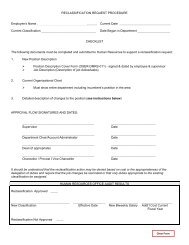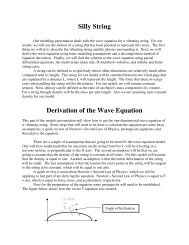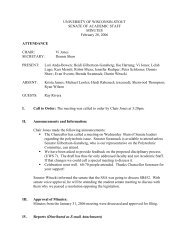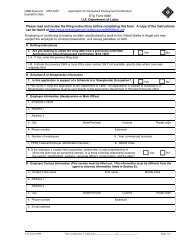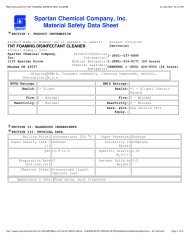1 Affinity Diagram (affinity chart, K-J method) Description The affinity ...
1 Affinity Diagram (affinity chart, K-J method) Description The affinity ...
1 Affinity Diagram (affinity chart, K-J method) Description The affinity ...
Create successful ePaper yourself
Turn your PDF publications into a flip-book with our unique Google optimized e-Paper software.
<strong>Affinity</strong> <strong>Diagram</strong> (<strong>affinity</strong> <strong>chart</strong>, K‐J <strong>method</strong>)<strong>Description</strong><strong>The</strong> <strong>affinity</strong> diagram organizes a large number of ideas into their natural relationships. This <strong>method</strong> taps ateam’s creativity and intuition. It was created in the 1960s by Japanese anthropologist Jiro Kawakita.When to Use an <strong>Affinity</strong> <strong>Diagram</strong>• When you are confronted with many facts or ideas in apparent chaos• When issues seem too large and complex to grasp• When group consensus is necessaryTypical situations are:• After a brainstorming exercise• When analyzing verbal data, such as survey results.<strong>Affinity</strong> <strong>Diagram</strong> ProcedureMaterials needed: sticky notes or cards, marking pens, large work surface (wall, table, or floor).1. Record each idea with a marking pen on a separate sticky note or card. (During a brainstorming session,write directly onto sticky notes or cards if you suspect you will be following the brainstorm with an<strong>affinity</strong> diagram.) Randomly spread notes on a large work surface so all notes are visible to everyone.<strong>The</strong> entire team gathers around the notes and participates in the next steps.2. It is very important that no one talk during this step. Look for ideas that seem to be related in some way.Place them side by side. Repeat until all notes are grouped. It’s okay to have “loners” that don’t seem tofit a group. It’s all right to move a note someone else has already moved. If a note seems to belong intwo groups, make a second note.3. You can talk now. Participants can discuss the shape of the <strong>chart</strong>, any surprising patterns, and especiallyreasons for moving controversial notes. A few more changes may be made. When ideas are grouped,select a heading for each group. Look for a note in each grouping that captures the meaning of thegroup. Place it at the top of the group. If there is no such note, write one. Often it is useful to write orhighlight this note in a different color.4. Combine groups into “supergroups” if appropriate.(Adapted from Nancy R. Tague’s book <strong>The</strong> Quality Toolbox, Published by ASQ Quality Press)1
Brainstorming<strong>Description</strong>Brainstorming is a <strong>method</strong> for generating a large number of creative ideas in a short period of time.When to Use Brainstorming• When a broad range of options is desired.• When creative, original ideas are desired.• When participation of the entire group is desired.Brainstorming ProcedureMaterials needed: flip<strong>chart</strong>, marking pens, tape and blank wall space.1. Review the rules of brainstorming with the entire group:o No criticism, no evaluation, no discussion of ideas.o <strong>The</strong>re are no stupid ideas. <strong>The</strong> wilder the better.o All ideas are recorded.o Piggybacking is encouraged: combining, modifying, expanding others’ ideas.2. Review the topic or problem to be discussed. Often it is best phrased as a “why,” “how,” or “what”question. Make sure everyone understands the subject of the brainstorm.3. Allow a minute or two of silence for everyone to think about the question.4. Invite people to call out their ideas. Record all ideas, in words as close as possible to those used by thecontributor. No discussion or evaluation of any kind is permitted.5. Continue to generate and record ideas until several minutes’ silence produces no more.(Adapted from Nancy R. Tague’s book <strong>The</strong> Quality Toolbox, Published by ASQ Quality Press)2
Stepladder Technique<strong>Description</strong><strong>The</strong> Stepladder Technique is a simple tool that manages how members enter the decision‐making group.Developed by Steven Rogelberg, Janet Barnes‐Farrell and Charles Lowe in 1992, it encourages all members tocontribute on an individual level BEFORE being influenced by anyone else. This results in a wider variety of ideas,prevents people from "hiding" within the group, and it helps people avoid being "stepped on" or overpoweredby stronger, louder group members.When to Use the Stepladder Technique• When seeking a wider variety of ideas• Allows shy, quiet people to present their ideas before other group members can influence them• Allows everyone to hear many different viewpoints before reaching a final decision.Stepladder Technique Procedure<strong>The</strong> Stepladder Technique has five basic steps. Here's how it works.Step 1: Before getting together as a group, present the task or problem to all members. Give everyonesufficient time to think about what needs to be done and to form their own opinions on how to bestaccomplish the task or solve the problem.Step 2: Form a core group of two members. Have them discuss the problem.Step 3: Add a third group member to the core group. <strong>The</strong> third member presents ideas to the first twomembers BEFORE hearing the ideas that have already been discussed. After all three members have laidout their solutions and ideas, they discuss their options together.Step 4: Repeat the same process by adding a fourth member, and so on, to the group. Allow time fordiscussion after each additional member has presented his or her ideas.Step 5: Reach a final decision only after all members have been brought in and presented their ideas.(Adapted from James Manktelow’s book Mind Tools, Published by Mind Tools Ltd)3
Fishbone <strong>Diagram</strong> (Cause‐and‐Effect <strong>Diagram</strong>, Ishikawa <strong>Diagram</strong>)<strong>Description</strong><strong>The</strong> fishbone diagram identifies many possible causes for an effect or problem. It can be used to structure abrainstorming session. It immediately sorts ideas into useful categories.When to Use a Fishbone <strong>Diagram</strong>• When identifying possible causes for a problem.• Especially when a team’s thinking tends to fall into ruts.Fishbone <strong>Diagram</strong> ProcedureMaterials needed: flip<strong>chart</strong> or whiteboard, marking pens.1. Agree on a problem statement (effect). Write it at the center right of the flip<strong>chart</strong> or whiteboard. Draw abox around it and draw a horizontal arrow running to it.2. Brainstorm the major categories of causes of the problem. If this is difficult use generic headings:o Methodso Machines (equipment)o People (manpower)o Materialso Measuremento Environment3. Write the categories of causes as branches from the main arrow.4. Brainstorm all the possible causes of the problem. Ask: “Why does this happen?” As each idea is given,the facilitator writes it as a branch from the appropriate category. Causes can be written in severalplaces if they relate to several categories.5. Again ask “why does this happen?” about each cause. Write sub‐causes branching off the causes.Continue to ask “Why?” and generate deeper levels of causes. Layers of branches indicate causalrelationships.6. When the group runs out of ideas, focus attention to places on the <strong>chart</strong> where ideas are few.7.(Adapted from Nancy R. Tague’s book <strong>The</strong> Quality Toolbox, Published by ASQ Quality Press)4
Force Field Analysis<strong>Description</strong>Force Field Analysis is a useful technique for looking at all the forces for and against a decision. In effect, it is aspecialized <strong>method</strong> of weighing pros and cons.When to Use a Force Field Analysis• When trying to understanding the pressures for and against change• When it is critical to strengthen the forces supporting a decision, and reduce the impact of opposition toit.Force Field Analysis Procedure1. Describe the current situation2. Describe the desired situation3. Identify where the current situation will go if no action is taken4. List all the forces driving change toward the desired situation5. List all the forces resisting change toward the desired situation6. Discuss and interrogate all of the forces: are they valid? can they be changed? which are the criticalones?7. Allocate a score to each of the forces using a numerical scale e.g. 1=extremely weak and 10=extremelystrong8. Chart the forces by listing (to strength scale) the driving forces on the left and restraining forces on theright.9. Determine whether change is viable and progress can occur10. Discuss how the change can be affected by decreasing the strength of the restraining forces or byincreasing the strength of driving forces.11. Keep in mind that increasing the driving forces or decreasing the restraining forces may increase ordecrease other forces or even create new ones.(Based on "Kurt Lewin's article, Contribution and a summary of <strong>method</strong>ology in analyzing change)5
Relations <strong>Diagram</strong> (interrelationship diagram or digraph, network diagram)Variation: matrix relations diagram<strong>Description</strong><strong>The</strong> relations diagram shows cause‐and‐effect relationships. Just as importantly, the process of creating arelations diagram helps a group analyze the natural links between different aspects of a complex situation.When to Use a Relations <strong>Diagram</strong>• When trying to understand links between ideas or cause‐and‐effect relationships, such as when trying toidentify an area of greatest impact for improvement.• When a complex issue is being analyzed for causes.• When a complex solution is being implemented.• After generating an <strong>affinity</strong> diagram, cause‐and‐effect diagram or tree diagram, to more completelyexplore the relations of ideas.Relations <strong>Diagram</strong> Basic ProcedureMaterials needed: sticky notes or cards, large paper surface (newsprint or two flip<strong>chart</strong> pages taped together),marking pens, tape.1. Write a statement defining the issue that the relations diagram will explore. Write it on a card or stickynote and place it at the top of the work surface.2. Brainstorm ideas about the issue and write them on cards or notes. If another tool has preceded thisone, take the ideas from the <strong>affinity</strong> diagram, the most detailed row of the tree diagram or the finalbranches on the fishbone diagram. You may want to use these ideas as starting points and brainstormadditional ideas.3. Place one idea at a time on the work surface and ask: “Is this idea related to any others?” Place ideasthat are related near the first. Leave space between cards to allow for drawing arrows later. Repeat untilall cards are on the work surface.4. For each idea, ask, “Does this idea cause or influence any other idea?” Draw arrows from each idea tothe ones it causes or influences. Repeat the question for every idea.5. Analyze the diagram:o Count the arrows in and out for each idea. Write the counts at the bottom of each box. <strong>The</strong> oneswith the most arrows are the key ideas.ooNote which ideas have primarily outgoing (from) arrows. <strong>The</strong>se are basic causes.Note which ideas have primarily incoming (to) arrows. <strong>The</strong>se are final effects that also may becritical to address.Be sure to check whether ideas with fewer arrows also are key ideas. <strong>The</strong> number of arrows is only an indicator,not an absolute rule. Draw bold lines around the key ideas.(Adapted from Nancy R. Tague’s book <strong>The</strong> Quality Toolbox, Published by ASQ Quality Press)6
Scatter <strong>Diagram</strong> (scatter plot, X–Y graph)<strong>Description</strong><strong>The</strong> scatter diagram graphs pairs of numerical data, with one variable on each axis, to look for a relationshipbetween them. If the variables are correlated, the points will fall along a line or curve. <strong>The</strong> better thecorrelation, the tighter the points will hug the line.When to Use a Scatter <strong>Diagram</strong>• When you have paired numerical data.• When your dependent variable may have multiple values for each value of your independent variable.• When trying to determine whether the two variables are related, such as…o When trying to identify potential root causes of problems.o After brainstorming causes and effects using a fishbone diagram, to determine objectivelywhether a particular cause and effect are related.o When determining whether two effects that appear to be related both occur with the samecause.o When testing for autocorrelation before constructing a control <strong>chart</strong>.Scatter <strong>Diagram</strong> Procedure1. Collect pairs of data where a relationship is suspected.2. Draw a graph with the independent variable on the horizontal axis and the dependent variable on thevertical axis. For each pair of data, put a dot or a symbol where the x‐axis value intersects the y‐axisvalue. (If two dots fall together, put them side by side, touching, so that you can see both.)3. Look at the pattern of points to see if a relationship is obvious. If the data clearly form a line or a curve,you may stop. <strong>The</strong> variables are correlated. You may wish to use regression or correlation analysis now.Otherwise, complete steps 4 through 7.4. Divide points on the graph into four quadrants. If there are X points on the graph,o Count X/2 points from top to bottom and draw a horizontal line.o Count X/2 points from left to right and draw a vertical line.o If number of points is odd, draw the line through the middle point.5. Count the points in each quadrant. Do not count points on a line.6. Add the diagonally opposite quadrants. Find the smaller sum and the total of points in all quadrants.A = points in upper left + points in lower rightB = points in upper right + points in lower leftQ = the smaller of A and BN = A + B7. Look up the limit for N on the trend test table.o If Q is less than the limit, the two variables are related.o If Q is greater than or equal to the limit, the pattern could have occurred from random chance.(Adapted from Nancy R. Tague’s book <strong>The</strong> Quality Toolbox, Published by ASQ Quality Press)7
Six Thinking Hats<strong>Description</strong>"Six Thinking Hats" is a powerful technique that helps you look at important decisions from a number ofdifferent perspectives. It helps you make better decisions by pushing you to move outside your habitual ways ofthinking. As such, it helps you understand the full complexity of a decision, and spot issues and opportunitieswhich you might otherwise not notice.When to Use Six Thinking Hats• When need for evaluating a decision from many points of viewSix Thinking Hats ProcedureTo use Six Thinking Hats to improve the quality of your decision‐making, look at the decision "wearing" each ofthe thinking hats in turn. Each "Thinking Hat" is a different style of thinking. <strong>The</strong>se are explained below:1. White Hat: With this thinking hat, you focus on the data available. Look at the information you have,and see what you can learn from it. Look for gaps in your knowledge, and either try to fill them or takeaccount of them. This is where you analyze past trends, and try to extrapolate from historical data.2. Red Hat: Wearing the red hat, you look at the decision using intuition, gut reaction, and emotion. Alsotry to think how other people will react emotionally, and try to understand the intuitive responses ofpeople who do not fully know your reasoning.3. Black Hat: When using black hat thinking, look at things pessimistically, cautiously and defensively. Tryto see why ideas and approaches might not work. This is important because it highlights the weak pointsin a plan or course of action. It allows you to eliminate them, alter your approach, or preparecontingency plans to counter problems that arise.Black Hat thinking helps to make your plans tougher and more resilient. It can also help you to spot fatalflaws and risks before you embark on a course of action. Black Hat thinking is one of the real benefits ofthis technique, as many successful people get so used to thinking positively that often they cannot seeproblems in advance, leaving them under‐prepared for difficulties.4. Yellow Hat: <strong>The</strong> yellow hat helps you to think positively. It is the optimistic viewpoint that helps you tosee all the benefits of the decision and the value in it, and spot the opportunities that arise from it.Yellow Hat thinking helps you to keep going when everything looks gloomy and difficult.5. Green Hat: <strong>The</strong> Green Hat stands for creativity. This is where you can develop creative solutions to aproblem. It is a freewheeling way of thinking, in which there is little criticism of ideas. A whole range ofcreativity tools can help you here.6. Blue Hat: <strong>The</strong> Blue Hat stands for process control. This is the hat worn by people chairing meetings.When running into difficulties because ideas are running dry, they may direct activity into Green Hatthinking. When contingency plans are needed, they will ask for Black Hat thinking, and so on.You can use Six Thinking Hats in meetings or on your own. In meetings it has the benefit of defusing thedisagreements that can happen when people with different thinking styles discuss the same problem. A similarapproach is to look at problems from the point of view of different professionals (e.g. doctors, architects, salesdirectors) or different customers.(Adapted from Edward de Bono’s book, 6 Thinking Hats, published by Back Bay Books).8
SWOT Analysis<strong>Description</strong>SWOT Analysis is a powerful technique for understanding your Strengths and Weaknesses, and for looking at theOpportunities and Threats you face.When to Use SWOT• When need to easily uncover opportunities that you are well placed to exploit• When it’s critical to understand the weaknesses of your business in order to manage and eliminatethreats that would otherwise catch you unaware.• When there’s a need to craft a strategy that helps you distinguish yourself from your competitors, sothat you can compete successfully in your market.SWOT ProcedureTo carry out a SWOT Analysis, answer the following questions:Strengths:• What advantages does your company have?• What do you do better than anyone else?• What unique or lowest‐cost resources do you have access to?• What do people in your market see as your strengths?• What factors mean that you "get the sale"?Consider this from an internal perspective, and from the point of view of your customers and people in yourmarket. Be realistic: It's far too easy to fall prey to "not invented here syndrome". (If you are having anydifficulty with this, try writing down a list of your characteristics. Some of these will hopefully be strengths!)In looking at your strengths, think about them in relation to your competitors ‐ for example, if all yourcompetitors provide high quality products, then a high quality production process is not a strength in themarket, it is a necessity.Weaknesses:• What could you improve?• What should you avoid?• What are people in your market likely to see as weaknesses?• What factors lose you sales?Again, consider this from an internal and external basis: Do other people seem to perceive weaknesses that youdo not see? Are your competitors doing any better than you? It is best to be realistic now, and face anyunpleasant truths as soon as possible.Opportunities:9
• Where are the good opportunities facing you?• What are the interesting trends you are aware of?Useful opportunities can come from such things as:• Changes in technology and markets on both a broad and narrow scale• Changes in government policy related to your field• Changes in social patterns, population profiles, lifestyle changes, etc.• Local eventsA useful approach for looking at opportunities is to look at your strengths and ask yourself whether these openup any opportunities.Alternatively, look at your weaknesses and ask yourself whether you could create opportunities by eliminatingthem.Threats:• What obstacles do you face?• What is your competition doing that you should be worried about?• Are the required specifications for your job, products or services changing?• Is changing technology threatening your position?• Do you have bad debt or cash‐flow problems?• Could any of your weaknesses seriously threaten your business?Carrying out this analysis will often be illuminating ‐ both in terms of pointing out what needs to be done, and inputting problems into perspective.Strengths and weaknesses are often internal to your organization. Opportunities and threats often relate toexternal factors. For this reason the SWOT Analysis is sometimes called Internal‐External Analysis and the SWOTMatrix is sometimes called an IE Matrix Analysis Tool.You can also apply SWOT Analysis to your competitors. As you do this, you'll start to see how and where youshould compete against them.(Adapted from James Manktelow’s book Mind Tools, Published by Mind Tools Ltd)10
Tree <strong>Diagram</strong> (systematic diagram, tree analysis, analytical tree, hierarchy diagram )<strong>Description</strong><strong>The</strong> tree diagram starts with one item that branches into two or more, each of which branch into two or more,and so on. It looks like a tree, with trunk and multiple branches.It is used to break down broad categories into finer and finer levels of detail. Developing the tree diagram helpsyou move your thinking step by step from generalities to specifics.When to Use a Tree <strong>Diagram</strong>• When an issue is known or being addressed in broad generalities and you must move to specific details,such as when developing logical steps to achieve an objective.• When developing actions to carry out a solution or other plan.• When analyzing processes in detail.• When probing for the root cause of a problem.• When evaluating implementation issues for several potential solutions.• After an <strong>affinity</strong> diagram or relations diagram has uncovered key issues.• As a communication tool, to explain details to others.Tree <strong>Diagram</strong> Procedure1. Develop a statement of the goal, project, plan, problem or whatever is being studied. Write it at the top(for a vertical tree) or far left (for a horizontal tree) of your work surface.2. Ask a question that will lead you to the next level of detail. For example:o For a goal, action plan or work breakdown structure: “What tasks must be done to accomplishthis?” or “How can this be accomplished?”ooFor root‐cause analysis: “What causes this?” or “Why does this happen?”For gozinto <strong>chart</strong>: “What are the components?” (Gozinto literally comes from the phrase “Whatgoes into it?”Brainstorm all possible answers. If an <strong>affinity</strong> diagram or relationship diagram has been done previously,ideas may be taken from there. Write each idea in a line below (for a vertical tree) or to the right of (fora horizontal tree) the first statement. Show links between the tiers with arrows.3. Do a “necessary and sufficient” check. Are all the items at this level necessary for the one on the levelabove? If all the items at this level were present or accomplished, would they be sufficient for the oneon the level above?4. Each of the new idea statements now becomes the subject: a goal, objective or problem statement. Foreach one, ask the question again to uncover the next level of detail. Create another tier of statementsand show the relationships to the previous tier of ideas with arrows. Do a “necessary and sufficientcheck” for each set of items.5. Continue to turn each new idea into a subject statement and ask the question. Do not stop until youreach fundamental elements: specific actions that can be carried out, components that are not divisible,root causes.6. Do a “necessary and sufficient” check of the entire diagram. Are all the items necessary for theobjective? If all the items were present or accomplished, would they be sufficient for the objective?11
(Adapted from Nancy R. Tague’s book <strong>The</strong> Quality Toolbox, Published by ASQ Quality Press)12
Cost/Benefit Analysis (CBA)<strong>Description</strong>You may have been intensely creative in generating solutions to a problem, and rigorous in your selection of thebest one available. However, this solution may still not be worth implementing, as you may invest a lot of timeand money in solving a problem that is not worthy of this effort.When to Use CBA• When cost is a factor in whether or not to proceed with a projectCBA ProcedureCost Benefit Analysis or cba is a relatively simple and widely used technique for deciding whether to make achange. As its name suggests, you simply add up the value of the benefits of a course of action, and subtract thecosts associated with it.Costs are either one‐off, or may be ongoing. Benefits are most often received over time. We build this effect oftime into our analysis by calculating a payback period. This is the time it takes for the benefits of a change torepay its costs. Many companies look for payback on projects over a specified period of time e.g. three years.In its simple form, cost‐benefit analysis is carried out using only financial costs and financial benefits. Forexample, a simple cost benefit ratio for a road scheme would measure the cost of building the road, andsubtract this from the economic benefit of improving transport links. It would not measure either the cost ofenvironmental damage or the benefit of quicker and easier travel to work.A more sophisticated approach to building a cost benefit models is to try to put a financial value on intangiblecosts and benefits. This can be highly subjective ‐ is, for example, a historic water meadow worth $25,000, or isit worth $500,000 because if its environmental importance? What is the value of stress‐free travel to work in themorning?<strong>The</strong>se are all questions that people have to answer, and answers that people have to defend.(Adapted from Richard Brealey and Stewart Myers’ book Principles of Corporate Finance published by McGrawHill)13
Dots Technique (Multi‐voting, NGT voting, nominal prioritization)<strong>Description</strong>Dots Technique narrows a large list of possibilities to a smaller list of the top priorities or to a final selection.Dots Technique is preferable to straight voting because it allows an item that is favored by all, but not the topchoice of any, to rise to the top.When to Use Dots Technique• After brainstorming or some other expansion tool has been used to generate a long list of possibilities.• When the list must be narrowed down, and.• When the decision must be made by group judgment.Dots Technique ProcedureMaterials needed: flip<strong>chart</strong> or whiteboard, marking pens, colored stick on dots.1. Display the list of options. Combine duplicate items. <strong>Affinity</strong> diagrams can be useful to organize largenumbers of ideas and eliminate duplication and overlap. List reduction may also be useful.2. Number (or letter) all items.3. Decide how many items must be on the final reduced list. Decide also how many choices each memberwill vote for. Usually, five choices are allowed. <strong>The</strong> longer the original list, the more votes will beallowed, up to 10.4. Working individually, each member sticks five dots (or whatever number of choices is allowed) on theitems he or she thinks most important. (Variations include allowing different color dots to be worthmore weight than others, or allowing a person to put more than one dot on a particular item if he or shefeels that it is extremely important)5. Tally votes and see which items are viewed as most important(Adapted from Nancy R. Tague’s book <strong>The</strong> Quality Toolbox, Published by ASQ Quality Press)14
Nominal Group Technique (NGT)<strong>Description</strong>Nominal group technique (NGT) is a structured <strong>method</strong> for group brainstorming that encourages contributionsfrom everyone.When to Use Nominal Group Technique• When some group members are much more vocal than others.• When some group members think better in silence.• When there is concern about some members not participating.• When the group does not easily generate quantities of ideas.• When all or some group members are new to the team.• When the issue is controversial or there is heated conflict.Nominal Group Technique ProcedureMaterials needed: paper and pen or pencil for each individual, flip<strong>chart</strong>, marking pens, tape.1. State the subject of the brainstorming. Clarify the statement as needed until everyone understands it.2. Each team member silently thinks of and writes down as many ideas as possible in a set period of time(5 to 10 minutes).3. Each member in turn states aloud one idea. Facilitator records it on the flip<strong>chart</strong>.o No discussion is allowed, not even questions for clarification.o Ideas given do not need to be from the team member’s written list. Indeed, as time goes on,many ideas will not be.o A member may “pass” his or her turn, and may then add an idea on a subsequent turn.Continue around the group until all members pass or for an agreed‐upon length of time.4. Discuss each idea in turn. Wording may be changed only when the idea’s originator agrees. Ideas may bestricken from the list only by unanimous agreement. Discussion may clarify meaning, explain logic oranalysis, raise and answer questions, or state agreement or disagreement.5. Prioritize the ideas using multivoting or list reduction.(Adapted from Nancy R. Tague’s book <strong>The</strong> Quality Toolbox, Published by ASQ Quality Press)15
Pareto Analysis (Pareto diagram, Pareto Chart)<strong>Description</strong>A Pareto <strong>chart</strong> is a bar graph. <strong>The</strong> lengths of the bars represent frequency or cost (time or money), and arearranged with longest bars on the left and the shortest to the right. In this way the <strong>chart</strong> visually depicts whichsituations are more significant.When to Use a Pareto Chart• When analyzing data about the frequency of problems or causes in a process.• When there are many problems or causes and you want to focus on the most significant.• When analyzing broad causes by looking at their specific components.• When communicating with others about your data.Pareto Chart Procedure1. Decide what categories you will use to group items.2. Decide what measurement is appropriate. Common measurements are frequency, quantity, cost andtime.3. Decide what period of time the Pareto <strong>chart</strong> will cover: One work cycle? One full day? A week?4. Collect the data, recording the category each time. (Or assemble data that already exist.)5. Subtotal the measurements for each category.6. Determine the appropriate scale for the measurements you have collected. <strong>The</strong> maximum value will bethe largest subtotal from step 5. (If you will do optional steps 8 and 9 below, the maximum value will bethe sum of all subtotals from step 5.) Mark the scale on the left side of the <strong>chart</strong>.7. Construct and label bars for each category. Place the tallest at the far left, then the next tallest to itsright and so on. If there are many categories with small measurements, they can be grouped as “other.”Steps 8 and 9 are optional but are useful for analysis and communication.8. Calculate the percentage for each category: the subtotal for that category divided by the total for allcategories. Draw a right vertical axis and label it with percentages. Be sure the two scales match: Forexample, the left measurement that corresponds to one‐half should be exactly opposite 50% on theright scale.9. Calculate and draw cumulative sums: Add the subtotals for the first and second categories, and place adot above the second bar indicating that sum. To that sum add the subtotal for the third category, andplace a dot above the third bar for that new sum. Continue the process for all the bars. Connect thedots, starting at the top of the first bar. <strong>The</strong> last dot should reach 100 percent on the right scale.(Adapted from Nancy R. Tague’s book <strong>The</strong> Quality Toolbox, Published by ASQ Quality Press)16
PMI (Plus/Minus/Interesting)<strong>Description</strong>PMI is a valuable improvement to the 'weighing pros and cons' technique used for centuries.When to Use a PMI• When selecting a course of action from a range of options• When evaluating whether we can actually improve the situation (it may actually be best to do nothing!)PMI ProcedureIn the column underneath 'Plus', write down all the positive results of taking the action. Underneath 'Minus'write down all the negative effects. In the 'Interesting' column write down the implications and possibleoutcomes of taking the action, whether positive, negative, or uncertain.By this stage it may already be obvious whether or not you should implement the decision. If it is not, considereach of the points you have written down and assign a positive or negative score to it appropriately. <strong>The</strong> scoresyou assign may be quite subjective.Once you have done this, add up the score. A strongly positive score shows that an action should be taken, astrongly negative score that it should be avoided.(Excerpted from James Manktelow’s book Mind Tools, Published by Mind Tools Ltd)17




